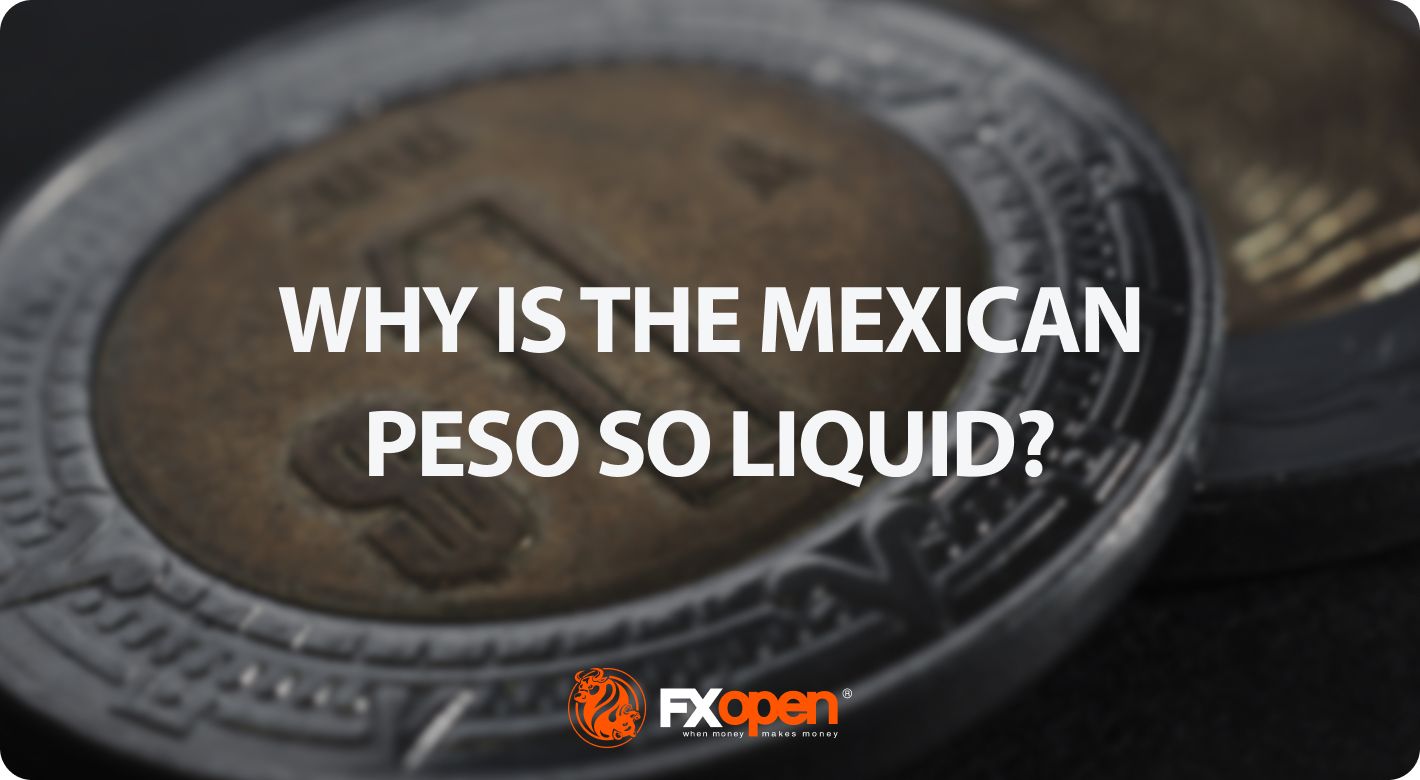FXOpen

The Mexican peso, a dynamic player in the global forex market, embodies a unique blend of historical resilience and modern financial attractiveness. As we delve into the reasons behind its impressive liquidity, this article offers valuable insights for traders and investors eager to understand the intricacies and opportunities presented by one of Latin America's most prominent currencies.
The Mexican Peso: An Overview
The Mexican peso, a currency with a rich history and a significant presence in the global market, often surprises investors asking, “How much is the Mexican peso worth?” when they discover it’s one of the strongest emerging market currencies around.
Its performance in the forex market is closely tied to macroeconomic indicators, particularly those from the United States, including benchmark interest rates. The currency has benefitted from Mexico's nearshoring boom and soaring remittances, alongside a healthy fiscal position, contributing to its appeal to investors and traders worldwide.
As the most traded currency in Latin America, the Mexican peso’s popularity underscores its importance in the regional and global financial landscape. With this background in mind, let’s take a look at 3 reasons the Mexican peso is so liquid.
Reason 1: Strong Economic Fundamentals
The liquidity of the Mexican peso today is closely tied to Mexico's strong economic fundamentals. In 2023, Mexico's economy has shown resilience and growth, marked by a significant increase in exports. This export-driven growth, reaching a record high, is supported by Mexico's robust trade relationship with the United States, making it the US's top trade partner with nearly $600 billion in two-way trade over the first nine months of 2023.
Inflation control is another pillar of Mexico's economic stability. After peaking at 8.7% in 2022, inflation has been effectively managed, witnessing a decrease to around 4.26% in October 2023. This decline demonstrates the successful monetary policies of the Bank of Mexico, indicating a resilient economic environment.
A key indicator of this economic improvement is in a comparison of the US dollar currency to the Mexican peso. In July 2023, the peso reached a low of 16.62 pesos per dollar vs a peak of 25.7 pesos per dollar in April 2020, showcasing its strongest performance in recent times. This strength is a direct reflection of investor confidence in the Mexican economy and can be observed in FXOpen’s free TickTrader platform.
Additionally, foreign direct investment (FDI) in Mexico has reached new heights, with almost $33 billion recorded in the first nine months of 2023. The announcement of significant investments, like Tesla's planned "gigafactory" in Nuevo León, underscores the international business community's interest in Mexico, contributing to the peso's liquidity.
Reason 2: Active Participation by the Central Bank
The liquidity of the Mexican peso is significantly reinforced by the active role of Banco de México, the country’s central bank. The bank's monetary policy plays a crucial role in maintaining the attractiveness of the peso, which in turn contributes to its liquidity.
One of the key strategies employed by Banco de México is its effective management of the overnight interbank funding rate. Throughout 2023, Banco de México maintained a consistent approach to this rate, reflecting its commitment to financial stability.
For instance, the target for the overnight interbank funding rate has been kept unchanged at 11.25% for several periods in 2023, following a series of incremental increases in the preceding years. These decisions are a reflection of the bank's responsiveness to economic conditions and its aim to balance growth with price stability.
Another important aspect of the bank's policy is the accumulation and management of international reserves. These reserves, which exceeded USD 203 billion as of October 2023, provide a buffer against external economic shocks, helping the country maintain economic stability in the face of global volatility. This stability is essential for sustaining the peso's liquidity, as it reassures investors about the country's economic resilience.
Reason 3: High Trading Volume and Global Interest
The history of the Mexican peso reveals a journey of economic reforms and policy shifts that have shaped its current state in the global market. Over the years, these changes have been contributing to stabilisation and reliability of the peso, making it a more attractive option for traders and investors and boosting its trading volume.
This high trading volume creates a virtuous cycle that may further enhance the currency's liquidity. More trading volume signifies a greater number of transactions and a broader investor base, which, in turn, increases the currency's visibility and appeal in the global market. As more traders and investors engage with the peso, it may lead to rate stabilisation and smoother market movements, which are key factors for a liquid market.
Additionally, the factors previously discussed, such as the strong economic fundamentals and the active role of the central bank, contribute to this cycle. A growing economy, along with effective monetary policies, boosts investor confidence. In response, more traders and investors are drawn to the currency, thereby increasing its trading volume and liquidity, and the cycle repeats.
The Bottom Line
In conclusion, the Mexican peso's resilience and appeal are clear indicators of its significance in the forex market. With its robust economic fundamentals, proactive central bank policies, and high trading volume attracting global interest, the peso stands as an attractive currency for traders and investors. For those looking to engage with this dynamic currency, opening an FXOpen account offers a gateway to the vibrant world of Mexican peso trading, providing an opportunity to participate in the market's ongoing growth and vitality.
This article represents the opinion of the Companies operating under the FXOpen brand only. It is not to be construed as an offer, solicitation, or recommendation with respect to products and services provided by the Companies operating under the FXOpen brand, nor is it to be considered financial advice.
Stay ahead of the market!
Subscribe now to our mailing list and receive the latest market news and insights delivered directly to your inbox.








